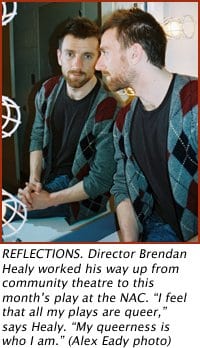Queer director Brendan Healy will direct French dramatist Molière’s final play Le Malade Imaginaire this month at the National Arts Centre. The play is a brand new translation by Adrienne Clarkson and John Van Burek entitled Dying to be Sick, co-produced by Toronto’s Pleiades Theatre.
Historical gossips suggest that Molière enjoyed intimate friendships with other men. Rumour has it that Molière left his wife for a handsome young boy. Whether or not these tales are true, this Renaissance playwright had a fascinating existence and a wonderful sense of humour, which shines through in his many popular plays.
The lead character of Dying to be Sick is a classic hypochondriac. Terrified of facing his mortality, he demands from his doctors countless cures for countless illnesses. And these immoral physicians have no qualms about taking advantage of his vulnerability. (Interesting historical tidbit: Molière played this role himself and died onstage during Act III.)
“I connect this play with plastic surgery,” says Healy. “It’s thought of as a desire to be beautiful, but it actually comes from a desire to be permanent — to retain youth.”
Healy emphasizes his own concerns regarding gratuitous or excessive medication. “There are so many risks. Like anal leakage — why would anyone take a pill [with that side effect]? Just to keep your erection, keep your hair.”
Although the modern medical profession has improved somewhat from blood-letting and urine-drinking, it is still difficult to know which people and which treatments to trust. At a time when sexual health and overall bodily health is so important, Dying to be Sick approaches some essential issues about being aware of our bodies and taking care of ourselves.
“We would rather give over the responsibility to strangers than to ourselves. The abdication of responsibility — it’s so human,” says Healy.
Like most theatre people, Healy began his career in community theatre and high school productions wanting to be in the spotlight. As an actor he worked with Peter Hinton, current Artistic Director of the NAC English Theatre, on Greg MacArthur’s Girls! Girls! Girls!
Only after completing a Bachelor of Fine Arts at Concordia University did Healy consider directing as the ideal profession. When one of his professors told him he had an instinct for directing, he thought, “Oh, that means I can’t act!” That was only until he realized that he was not in love with acting and wanted a more direct engagement over the script, more control over the material.
Although Healy admires a variety of theatre professionals, he acknowledges that his tastes are often naturally inclined towards queer culture and well-known queer playwrights, such as Tennessee Williams and Oscar Wilde.
“They have a queer perspective on things — it’s not universal,” explains Healy. “I feel that all my plays are queer. My queerness is so who I am.”
In 2006 Healy was the recipient of the Ken McDougall Award for Emerging Director. He has already made a name for himself at the Summerworks Theatre Festival (chosen to participate six years in a row) and at the Toronto Fringe Festival. Leading a mainstage show at the NAC is a huge step forward, but it looks like there’s much more to come for this spunky young director.

 Why you can trust Xtra
Why you can trust Xtra


